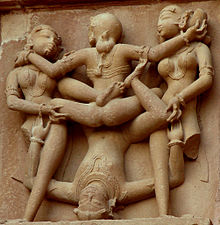Surasundari
As Surasundaris or Sura Sundaris ( Sanskrit : सूरासुंदरी = "Heavenly Beauty") are painted or sculptural representations of so-called "beautiful girls" in Indian art, who display their physical charms in various poses.
origin
Female figures - with the exception of goddesses or forest nymphs ( yakshis or salabhanjikas ) - were almost never depicted individually in early Buddhist painting and sculpture, but only in the company of men ( mithunas ). They only gradually emancipated themselves from their role as companions, but they never seek direct eye contact with the viewer. This form of representation experienced its undisputed climax in the temples of Khajuraho ; here they can be found both on the outside walls and inside the temples.
presentation
Unlike the salabhanjikas , who usually stand alone as niche or console figures ( bracket figures ), the surasundaris are always in company (men, birds, animals, etc.), but without paying much attention to these 'things'. Sometimes they dance alone, but mostly they put on make-up or - apparently - look oblivious to the world in the mirror. Sometimes they also assist in erotic scenes, but in most cases they stand by as if uninvolved. Their clothes are often almost see-through and are handled lasciviously; feminine charms (breasts, hips) are emphasized.
meaning
Apart from the fact that female beauty and eroticism were sung about and depicted in many cultures, it also seems to have a disastrous ( apotropaic ) meaning in Indian art - where beauty, love and eroticism are found, there is no longer any room for demonic and destructive forces. (A similar result - albeit without the erotic sphere - can also be observed in the development of European art in the transition period from the Romanesque to the Gothic .)
Quote
- Like a house without a wife, like happiness without women, a building without a surasundari is inferior and remains fruitless. (Art treatise Shilpa-Prakasha , 9th century)
See also
- Lakshmana Temple in Khajuraho
- Kandariya Mahadeva Temple in Khajuraho
literature
- Marilia Albanese: Ancient India. From the origins to the 13th century. Karl Müller-Verlag, Cologne undated, p. 146ff, ISBN 3-89893-009-2 .
- David Kinsley: Indian Goddesses. Female deities in Hinduism. Insel-Verlag, Frankfurt / M. 1990, ISBN 3-458-16118-X .
- Harsha Venilal Dehejia, Makarand R. Paranjape: Saundarya. Samvad India Foundation, 2003, ISBN 978-81-901318-0-3 .

